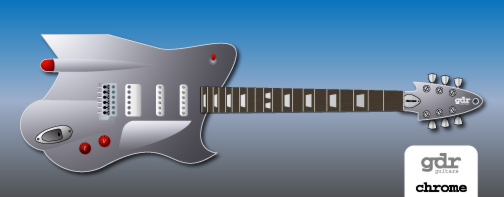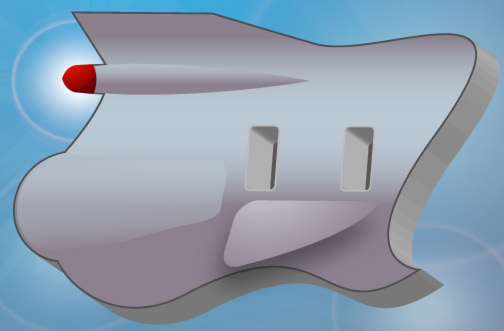The Harley Earl inspired tail-fin chrome guitar
I wrote a bit about Harley Earl over on designreviews.co.uk. On there it was about his cars and the superb style he put into those futuristic road machines. Lots of unnecessary chrome, styling quirks, not to mention tail fins on everything. Harley pioneered all that which reached it’s pinnacle with the 1959 Cadillac Eldorado.
It is from the 1959 Cadillac rear end that I have borrowed some style and shape for the back end of the guitar body design you see here. For the front end I have used a low bezier count single cut swash which I think helps give a sense of speed and movement to this guitar design! For the headstock I designed a shape based on a rocket/bullet head/harpoon. I liked the idea of the harpoon headstock so I added a hole like is traditionally found in a harpoon head. Also it’s a styling quirk that perhaps Mr Earl would have approved of. An alternative would be some kind of headlight headstock, that’s an idea to play with perhaps…

All in all it looks a pretty sleek guitar design, I think. There is a scratch-plate which I envisioned as a Les Paul type angled above the body. Also the bridge might be good if it was swapped for a Bigsby unit with the logo cut out from the chrome.

The guitar body design here is visualised in silver grey, there is carving where the tail-light ‘tubes’ merge with the body and the back bumper. I’d like for the upper tail-fin to get thinner as it tapers upwards. That would also bring more comfort to playing this guitar. I always think a guitar body design should have a lower horn so that you can rest it on your leg, it’s a pretty essential design feature that has always put me off owning any ‘V’ shaped guitar. After I did this guitar body design I wondered if anyone else had merged a 59 Cadillac with a guitar before, worried! So I had a look and there were several guitars with a Cadillac name but none with the design influences I’ve been talking about, they just seemed to use the name because it is ‘cool’! But there was one exception, indeed it is a ‘V’ shaped guitar so it’s OK for standing up, it looks a lot to me like the Randy Rhodes Jackson DX guitar. A ‘V’ shaped guitar but I prefer my more surf-like guitar design, it would be more practical and if made well would be a bit of a beauty I think!
If anyone is interested in this guitar body design I can send them a vector Illustrator or PDF file so it can be scaled and printed at actual guitar body size. Just let me know in comments below, I’d love this guitar design to be made/manufactured! Stay tuned for more guitar body and headstock designs! Cheers, Mark
5 thoughts on “The Harley Earl inspired tail-fin chrome guitar”
Leave a Reply
You must be logged in to post a comment.

Hi Mark…..while I like this more than your Trinity design, and appreciate that you plan to thin the top bass bout as it gains in height, I feel the visual suggestion of that area, while true to the car fins in question, will make virtually any player pause and reject purchasing this design. It’s just guaranteed to be either uncomfortable or catch on sleeves, straps, passersby, etc.
That’s one area of a guitar you simply can’t place anything sharp. Even Vee’s and Explorers are seriously rounded if you examine them carefully. The ‘wing’ on that bout has to be really long to get it out of the way enough to go pointy there, and then you have to worry about balance issues.
Check out Neal Moser’s FastStar type designs sometime…that’s about as far as you can go in that direction. (Possibly too far!) When standing, there’s only three places we touch a guitar, ( back, neck and top bass bout) and people are protective of them…so try to reserve extreme design features to where they’ll be less likely to impose on those comfort zones.
People are WAY more conservative about guitar design than one would presume, it’s counterintuitive at best, but guitar players are a fascist lot…not designers or sculptors themselves, they like what they know and will openly resist innovations, even good ones. I’ve had people tell me that there are six ‘proper’ guitar designs and no need for any more. It’s a defense mechanism that frees them from even considering anything so esoteric as design, which is obviously a less than manly thing to do. But that’s another subject.
One trick I like to use is to take an architect’s scale human and superimpose any design over it at full size, hung by its strap buttons, and see where a player’s arm Actually impacts it. That’ll let you know where to keep clear or add bevels to, etc.
But keep at it, try to learn something with each new design, and be your own harshest critic.
Hi Kerry, thanks for the great insight and info on the upper guitar body design considerations.
Yes, indeed guitar players seem to be a conservative lot, but guitar enthusiasts might be even more conservative.
I find a large percentage of articles on guitar subjects on the internet are focussed on the heavy metal area and the sport people call ‘shredding’. I’d call these people a vocal minority; compare, let’s say sales of CDs/concert tickets by The Rolling Stones and Led Zeppelin with artists like Yngwie Malmsteen or the most holy of shred guitarists Steven Vai! When I’m making guitar and headstock designs I’m thinking of the mainstream guitar based pop and rockers, who’s only choice seems to be Fender at the moment, as I see it! I think these Pawn Shop Guitars are going to be really big sellers. Gibson being classic rock, Ibanez = metal/jazz, PRS = boring old men. These are generalisations but that is how fashion works. Stratoblogster was saying the other day that designs are successful because big name artists take them up – that’s fashion.
Kerry, what CAD program do you use for guitar body designs? Cheers, Mark
Well I wouldn’t really agree that Fender is the only choice…we live in the richest guitar environment the world has ever seen. ( I don’t know what you see over in Blighty, but check out DestroyAllGuitars.com sometime, some of the best and most innovative luthiers can be seen all in one place.) One merely has to work enough years to afford them, LOL.
I also don’t believe that having a famous player playing a certain guitar is the test for a classic design, I believe it’s the other way around, it’s the classicness of the guitar that earns the players.
(If they’re not being openly sponsored and supplied). There are lots of prejudices folks carry with them in this area.
And mostly, that rests on offending the sensibilities of the FEWest players…whose design parameters may be wholly wrong-headed. Less is indeed more, when early models have become iconic. In fact the whole process is backwards and decided by the least knowledgeable…but that’s the Capitalist model at work. Luckily I can’t get anybody to look at my work in any credible way(!)…of course I’ve been very careful about who sees what. I’m not a free design factory.
I always wonder as I work what other designers (like Don Grosh, Bill Collings, Jeff Jones, Saul Koll, Jol Dantzig, Jack Briggs, Gene Baker, Dennis Fano, Doug Kauer –many of whom I am in contact with) will think of my work…and let the salesmen deal with the finished product should anything get that far along.
About CAD, so far I don’t have them done in 3D, but I am looking carefully at Rhino 3D, with a plug-in from T-Splines, that makes it much more organic and user-friendly, you should check them both out. The HoundDog (thanks for the link) was done in Scott’s CNC program, with the neck join, backshape and volute really the only difficult, handmade areas. Thanks for the compliment BTW, but rest assured that it is an intentionally ‘naive’ design…I have at least ninety ‘prettier’ things in the can. I try to cover a huge swath of guitar design, and that one just fit what StoneTree needed and would fit his clientele–and I had sold my P-90 guitar! A rich friend bought the prototype, which I hope to buy back one day. Scott went rather suddenly out of business shortly thereafter.
My process is as such:
I draw them first by hand, then ‘erase and trace’, then scan the tracings into my sign design program (Gerber) and then I tweak the digital outlines for hours, at full scale, spinning the designs around several times, considering them from all four angles, and visually ‘weigh’ing the bodies along the main axis to help keep them balanced. Headstocks can take as long as the body for each.
I also then design for bindings, plates and pickguards and locate hardware and knobs. I also do overlay shapes that can be shaded to suggest highlights and bevels, shadows, etc.
Then I take the digital wireframes into Adobe Illustrator to ‘dress’ them for showing. I’ve created huge banks of files so I can add all sorts of bridges, tuners, etc., I just pick and choose from stock necks, and such. I’ve been doing this as a sideline for about fifteen years.
I can also ‘skin’ them in AI, using clipping masks of any surface I can find. I’ll show you some, if you send me a secure place to do so and swear yourself to non-disclosure.
Hi Kerry, thanks for the info and links.
Also it’s really interesting to hear your process. If you don’t have a blog like this, you should have one, you can teach people a lot.
I have been using Adobe Illustrator for about 15 years, so I know this program inside out, it’s great for 2D work, the 3D is quite limited, OK for simple extrusions only. 2D only allows us to show the guitar curves from one angle! As a guitar’s beauty is in the curves 3D is definately the way to go to show a design before it’s made.
I think the body designs I have done will be passed to an experienced luthier who will do the ‘normal’ things that need doing, like carving the belly cut etc etc. That is satisfactory, but in a 3D program I could specify exactly what I would like doing, and show it. However it’s best perhaps, especially right now, to let an experienced guitar maker ‘finesse’ the shape provided by my 2D vector illustration.
I’ve tried a couple of 3D programs like Blender (baffling) and Sketchup (seems a bit rough, not sure). Recently I got the demo for Rhino but haven’t had time to even install it yet!
My primary goal is not to sell the designs on here, mostly I would like to see some of these illustrations breath, come to life and actually be made into guitars! If so I would appreciate one of the manufactured guitars 🙂 I understand that anything published here (the designs) will have my copyright, naturally, as it says at the bottom of the page.
I’m not sure about seeing your designs, it might influence me too much and I might design something similar!?!? I would really really appreciate a library of pickups, guitar hardware, tuners etc etc in Illustrator if you have that kind of thing? You can email me at mark?guitardesignreviews.com if you wish. (? = @) Cheers, Mark
P.S. on DestroyAllGuitars.com is it always the luthier who is also the designer? I don’t know why the guitar industry has this peculiarity, except that it might just work on a very small scale production. Architects don’t actually build houses and automobile designers are rarely seen with a spanner in their hand!?
I’m gonna be evil and make you digitize your own hardware, LOL. It’s good practice. Start measuring frets!
I never felt the overriding desire to go to 3D, because I can visualize it that way…if I couldn’t, I probably wouldn’t be a very good designer. So I don’t have to see it that way, I KNOW how it will look. Plus, having a few things left to specify gives me a reason to be kept around! My outlines are easily translated for cutting out, in 2D anyway. I work them very tight.
And yes, for some damn reason if you only do ‘the design work’, you get NO credit in the guitar world…it’s bizarre, I’ve used the Architect analogy a hundred times myself. I’ve spent thousands of hours getting good at it, but because I had a busy sign shop for years and had no time, and the climate in Miami is NOT conducive to building, I don’t make them myself. I’m fairly sure I could, I’ve done my homework and understand every step…but I think there are several factors at play.
First, America is DIY place and you’re considered lazy if you don’t go get a hunk of wood and start hacking away. Because that’s how the average bonehead on the street would do it. I wish I had a buck for every puzzled look and “What do you MEAN you haven’t made any of these?”s I’ve seen and heard, it freaks people out. Having any sort of restraint is mind-boggling to most. But, I realized early on that I could do ten designs in the time it would take to make one sodden hunk of junk that would ultimately become an embarassing reminder of my early hamfistedness.
Once a guy derides you for actually theorizing and understanding things without having made the mistakes in 3D, it makes what you’ve done somehow questionable and impossible to believe. You’d have to explain your entire process and all the steps you went through, effectively giving way all your time-earned secrets to convince them, which is ultimately what they want.
Also, for many of the less-than-tech-skilled, designing for machining is easy to demean. Any time new technology comes along, those who embrace it will be called Cheaters. ‘Handmade’ is considered better, whether it is or not. Cheap shots satisfy many.
The next reason is that there are egos involved…most of those who are good enough to do the handwork for a designer consider themselves artistic enough to dismiss or override the work of
other designers…you can’t sell a model to a guy who thinks he would have designed your guitar himself already, if it was any good. It’s a rare soul who will happily say, “shit, I thought I was good but your stuff blows me away, let’s do yours!” So anybody who’s made a ‘REAL’ guitar, however crappy, is somehow superior to you. Truth is, maybe one tenth of one percent of all humans are qualified to judge these things well.
AND, if he’s less skilled a designer, he can’t necessarily recognize why yours may in fact be nicer. Which sounds arrogant, but is simply a fact. Then all your sculpture, illustration, and calligraphic graces are gone in a poof of viewer-inferiority, which is a truly odd weapon, but effective.
The next reason is MONEY…once a guitar company has a design in hand, they generally feel the designer is superfluous and they’ll cut him out of the loop ASAP. I’ve worked with two companies and both shined me on immediately after the proto’s were done. It’s genuinely low, but they can simply say, “Hey, it’s just business”. Which means, “I screwed you, deal with it, because I won’t lose a minute’s sleep for having done it.” And it’s illegal to beat them to death.
Gibson has this outlook, and many of their designs came from people in-house who never got more than a pat on the back, while the corporation made millions. So if you go to work there, they make you work on the assembly line for a while to make you a common worker….it’s a way of demeaning your skills, which of course allows them to feel as though you’re no different than they are, so they can say their ideas are preferable because it’s all a matter of taste. Which you absolutely cannot point out, because then You’re the egomaniac.
Then they make you Propose the idea in front of a bunch of cutthroats who want their idea run in front of yours…so they’re quite happy to poison yours using any trick available. If you’re not as despicable– you have little chance. I’ve heard it from ex-employees there.
So be very careful about who sees what, and get things in Writing.
There’s really no winning, and I wonder often why I haven’t quit long ago.